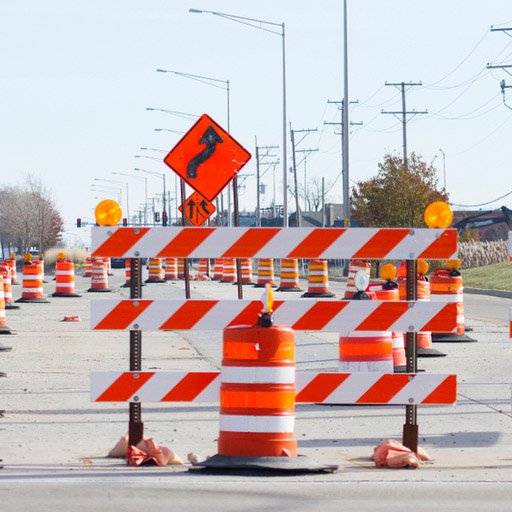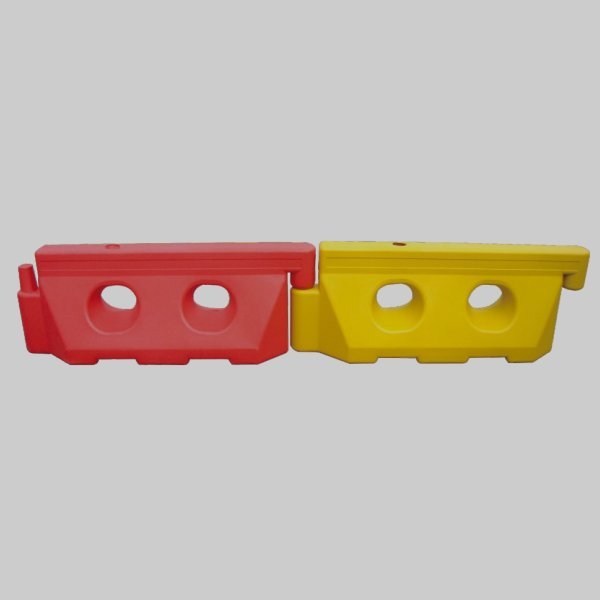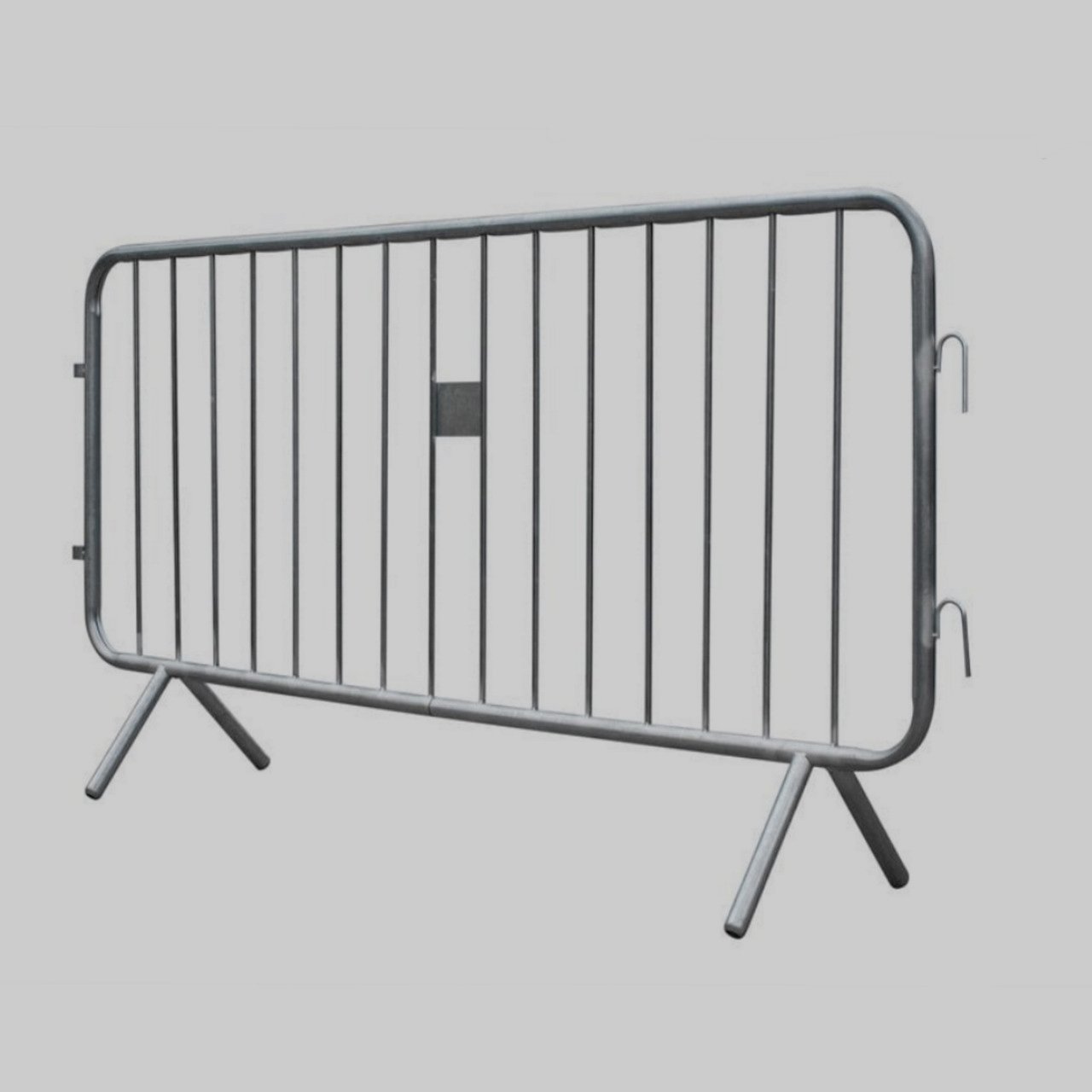If you manage road construction projects or road traffic, you already know about road barriers. However, it’s important for you to deeply understand road barriers to comply with safety regulations and do your job perfectly. Road barriers come in different types.
In this guide, you’ll learn about road barriers, their types, benefits, applications, compliances, and more. And by the end of this guide, you will know which road barrier to choose for your next road project.
What are Road Barriers?
Road barriers are physical structures made from plastic, metal, and often concrete. They are basically designed to manage traffic flow, redirect vehicles through detours, and reduce the risk of accidents. If we talk about their work, they keep drivers within their roadway. Plus, prevent vehicles from colliding into pedestrians, other vehicles, trees, walls, or heavy equipment.
You can use them on roads, highways, parking lots, walkways, construction sites, accident-prone zones and even on events. They not just let you control traffic as you want but also ensure your workers, drivers, and pedestrians safety.

Main Purpose of Road Barriers
Although there are several purposes of road barriers, but one main purpose of road barriers is safety and traffic control. When placed on roads, they prevent vehicles from leaving through road edges, entering into other lanes and also prevent them from colliding with hazards. That way, they help ensure safety and a well-managed traffic flow.
On top of that, they significantly help in accident mitigation. Means, even if a vehicle loses control and bumps into the barrier, they absorb vehicle impact and reduce the accident severity. They’re also widely used to create barriers between road and construction worksites, to protect construction workers.
Apart from that, road barriers have several secondary purposes too, that facilities often don’t consider. Such as they block unsightly views, reduce vehicle noise (if absorbent barriers), stabilize vehicles (in heavy winds), pollution control and wildlife protection.
What are Road Barriers Made of?
Different road barrier manufacturers use different types of material in the manufacturing of road barriers. However, Jackwin uses high-quality and durable materials and constructs road barriers through injection and blow molding processes. That way, the barriers’ features and quality enhance even more. Here is a list of materials that Jackwin uses:
Plastic: They are lightweight, easy to transport, place, and remove. You can use them for temporary setups like roadwork, public events, or emergency situations. They offer decent visibility, but may not be suitable for use in windy areas and roadways as they can trip easily.
HDPE (High-Density Polyethylene): They are UV-resistance, anti-aging, impact-resistance, long-life and can easily withstand heavy wind and rain. You can use them on roads, highways, and construction sites. Plus, most HDPE barriers are hollow, and you need to fill them with water or sand to make them stable on the road.
Metal: Made up of high-quality steel. They are strong, heavy-duty, durable, rust-free, and impact- and weather-resistant. You can use them in permanent or high-risk areas, such as highways, industrial sites, or sharp turns (where vehicles are more likely to lose control).
Permanent vs. Temporary Barriers: What’s the Difference?
When it comes to road barriers, understanding both of them is vital. They both serve different purposes and also distinguish between the material, advantages, and drawbacks.
So if we talk about temporary barriers, they are lightweight, affordable, easy to transport, set up, and remove. And often made with plastic and lightweight metal. That makes them a perfect choice for short-term projects (approx 3-4 months).
You can use them at construction zones, control traffic, parking lots, walkways and even at events (like concerts, marathons, etc). Despite their many benefits, they have some limitations. They can withstand moderate vehicle-impact and are not ideal for long-term and heavy-duty projects.
Permanent barriers, on the other hand, are expensive, and ideal for long-term projects or permanent placements. They are typically made with steel, concrete, and heavy-duty metal. That makes them a perfect choice for indefinite use. These barriers are very strong, high impact-resistant and sturdy.
You can use them at construction sites, highways, bridges, industrial facilities, or to manage traffic in high-speed areas. In its drawbacks, they require more manpower and machine power to place, move, and remove them. Plus, they are often more prone to vehicle crashes due to their sturdy structure.
Key Types of Common Road Barriers
Road barriers come in different types to cater to different traffic conditions as well as applications. In the section below, you’ll learn about key types of road barriers:
-
Type I, II, III Barricades
If we talk about these, they are striped-design barriers that you often see at walkways or on roads (near construction zones). Actually, they all serve the exact same purpose of blocking off roads or redirect vehicle and foot traffic, but differ in characteristics.
Type I barricade has one reflective panel, while Type II has two and Type III comes with three wide panels. With the increase in the panels, their characteristics also change. You can use them at walkways, low-speed roads, busier streets and construction zones (along with other barriers).

-
Water-Filled/Sand-Filled Barriers
As the name suggests, you need to fill these barriers with either sand or water. Because when empty, they’re lightweight and easy to move. So once you fill them, they become heavy and stabilize themselves on the road.
On top of that, Jackwin manufactures them with a bright-color body (for enhanced visibility) and uses HDPE (high-quality and durable plastic material) for its structure. That makes them more strong, flexible and high-impact. You can use them for short to medium term projects to separate lanes and manage smooth traffic flow.

-
Jersey Barriers
Although, water-filled barriers fall under Jersey barriers. But Jersey barriers are often made with concrete material, that’s why they are more sturdy, heavy-duty, durable and long-lasting. However, they are more expensive. Plus, they also fade under sunlight and rainy environments. However, you can use them for long-term projects or permanently in high-speed areas.

-
Metal Road Barriers
Jackwin uses heavy-duty steel material to manufacture these metal road barriers to make them heavy, durable, long-lasting, and extremely impact-resistance. You can use them for high-risk areas for both short and long-term projects. Such as at industrial sites, highways, urban projects. Apart from that, using them at your road construction site enables you to create a barrier between your workers and the road to ensure a safe zone.

-
Expandable Road Barriers
As the name suggests, you can expand them easily to increase their length. Jackwin made them in different types with portable, rotatable, and foldable characteristics for quick setups. So you can choose any of them based on your job needs. You can use them anywhere where there’s a need to create temporary blockage. Such as at airports, waiting and reception areas.

-
Traffic Cones
They’re widely used barriers on roads and workplaces. You can use them on roads, construction sites, building entrances, events and even in schools to redirect drivers and block off lanes or certain places. On top of that, Jackwin’s traffic cones are made up of high-quality PVC that makes them durable and strong enough to withstand windy weather.

Safety Benefits of Using Road Barriers
-
Reduces Driver Confusion
When you start a construction or road repair project, it causes drivers confusion as the way isn’t clear to them. So when you properly place barriers, they clear things up. Like they show block lanes and new safe paths.
-
Minimizes Secondary Accidents
Suppose there’s been an accident on the road. If you don’t separate the accident zone from the road, other drivers might get too close or crash into it. But using barriers, you can quickly block off the area. That way, other vehicles won’t get involved and hence you can save more lives.
-
Improves Work Zone Safety
At construction sites, workers face risks every day. In such site conditions, you can use barriers to create a protective wall between them and moving traffic.
-
Guides Traffic Flow
Apart from using barriers to create boundaries, you can also use them to block lanes and redirect traffic. This way, they help you take full control over managing traffic flow, keep things moving smoothly, and reduce traffic jams.
-
Supports Crowd Control
During public events, you need to manage heavy foot and vehicle traffic that’s often challenging. In such conditions, you can use road barriers to create boundaries. That helps you separate cars from crowds and create a safe walkway for pedestrians.
-
Buffers Against Environmental Hazards
You know that during strong winds, landslides, or roadside edges, vehicles often lose control and move out of the way. So when you use heavy-duty or water-filled barriers on roads and edges, they prevent vehicles from moving into danger.
Top 5 Applications of Road Barriers
-
Highway and Expressway Safety
On high-speed roads (highways or expressways), even a small distraction can lead to deadly crashes. Therefore, you can utilize road barriers to create a protective wall between opposite lanes or road edges. They stop vehicles from crossing over into the wrong direction. Plus, it significantly reduces major head-on collisions.
-
Construction Zones
At construction or repair zones, you need to alert drivers and guide them properly with the intention to ensure your workers safety as well as non-disrupted traffic flow. So here you can use water-filled and traffic cones barriers to mark off the work area. That tells vehicles not to come inside and from where to go.
-
Traffic Diversion and Lane Separation
In sudden emergencies or road repair, you need to quickly close one lane or shift traffic temporarily. In such conditions, you can use high-visibility plastic barriers to create a smooth detour or divide lanes. It keeps everything smooth and also prevents traffic jams.
-
Pedestrian Protection
In busy streets or event areas, people often walk close to traffic. In such conditions, you can use high-visibility and light-weight road barriers like traffic cones. These barriers help create a safe walking path by blocking off risky areas and telling pedestrians where to walk safely.
-
Event and Crowd Control
Road barriers are also widely used by event managers to control heavy foot-traffic and vehicles in outdoor locations. During city parades, concerts, or sports events, they are excellent to restrict specific areas and guide pedestrians and vehicles through a safe zone.
Road Barriers Standard and Regulations
Standards and regulations for road barriers are the rules that are mandated by the MUTCD and European Standard EN 1317. That means you cannot use any road barrier under any traffic and road conditions. Because, as per these compliance bodies, you’re allowed to use certain barriers that meet specific conditions. That’s why we’ve created a table below, explaining all standards:
| Specification | MUTCD (USA) | European Standard (EN 1317) |
| Purpose | Defines traffic control devices, including barriers for safety and guidance. | Specifies performance requirements for vehicle restraint systems (barriers). |
| Barrier Types | Guardrails, Crash cushions, Terminals | Safety barriers (metal, concrete), Crash cushions, Terminals & transitions |
| Performance Levels | Based on crash testing (NCHRP 350 / MASH – TL-1 to TL-4) | EN 1317 defines containment levels (N1, N2, H1-H4, etc.) and impact severity (A, B, C). |
| Placement Criteria | Roadside hazards, Medians, Work zones, and Bridge approaches | Roadside hazards, Medians, Urban areas, Motorways & high-speed roads |
| Height Requirements | Typically 27–32 inches (685–810 mm) for guardrails. | Varies by containment level (e.g., 700–900 mm for standard barriers). |
| Materials & Design | Steel (galvanized), Concrete, Plastic (HDPE, PVC) | Steel (hot-dip galvanized), Concrete, Composite materials (approved variants) |
| Crash Testing | MASH (Manual for Assessing Safety Hardware) standards (replaced NCHRP 350). | EN 1317-2 (impact performance) & EN 1317-3 (crash cushions). |
| Marking & Visibility | Retroreflective sheeting (yellow/white) for night visibility. | Reflective markings (white/red/yellow) compliant with EN 1436 (road marking standards). |
How to Choose a Correct Road Barrier?
Well, it’s very essential for every facility to learn what things to consider while choosing road barriers. Because your one wrong selection can pose a big disaster. That’s why, in the below section, we’ve shared a list of steps from our 18+ years at Jackwin, to help you choose the right road barrier for your next and future projects.
Step 1: Analyze Your Location
Start by checking your road or site area. Is it a construction zone, a highway repair area, or a public event? Because the type of location actually helps you decide what kind of barrier you need. Whether lightweight, portable, tall, or heavy-duty.
Step 2: Analyze Your Project Period
Next, you need to consider how long your project is going to take. If you’re placing barriers for just a few hours or days, we suggest you go with temporary options. Such as traffic cones, expandable barriers (portable or rotatable). But if it’s for weeks or months, go for durable and heavy barriers. Such as water-filled or metal barriers.
Step 3: Consider Barrier’s Visibility for Safety
Road barriers must be easy to see in both daytime and nighttime. Jackwin’s road barriers come with a bright-color body, with orange, yellow, and white colors that won’t fade and stay visible (even in low-light). Our traffic cones are also made with reflective tape for nighttime visibility.
Step 4: Measure the Road Space
Since you cannot block or control traffic with a single road barrier. So, always first measure how much space you’re blocking or guiding traffic through. This simple approach tells you in advance how many barriers you need and what size works best.
Step 5: Follow Local Safety Rules
Each region has rules about road safety equipment. So, make sure that you choose a supplier that manufactures barriers that meet MUTCD and European standard size, quality, color, and placement requirements. That way, you stay compliant and avoid fines.
Step 6: Choose the Right Material
Finally, when you have followed all the above steps, it’s time to choose the right material. We suggest you go with plastic material for easy setup, metal for strong boundaries, or water-filled for medium-to-long-term projects on high-speed zones.
Our Road Barrier Solutions for Every Need
Jackwin is a top Chinese road and traffic safety products’ manufacturer, working for 18+ years. We believe every road, worksite, or public zone deserves a top-notch-level protection. That’s why we design a wide range of road barriers that meets MUTCD and European standards.
Our road barriers are durable, strong, highly-visible, extremely impact-resistance, long-lasting and UV-resistance that can withstand all weather and outdoor conditions. In our products, water-filled barriers, expandable or retractable barriers, traffic cones, and heavy-duty metal barricades are included.
We also customize road barriers on clients’ projects needs and requirements in color, material, size, and weight. And because we manufacture everything in-house, you always get competitive wholesale pricing, bulk supply, and consistent quality, without cutting corners. So if you’re looking for road barriers, contact our team today to get an instant inquiry!
Innovations in Road Safety Barriers
- Rolling Barrier Guardrails
These guardrails are not like traditional metal rails. They come with spinning rollers (usually made of EVA or polyurethane) that absorb crash impact and turn it into a sliding motion. So, if a vehicle hits the barrier, instead of smashing into it, the rollers guide it along the road.
- Automated Rapid Movable Barriers (ARMB)
These are high-tech barriers you can move within minutes. They are perfect for roads that frequently switch lanes during peak traffic hours or need fast rerouting during emergencies.
Conclusion
We hope that by the end of this guide you have an understanding of road barriers, their types for different use cases and their benefits for ensuring everyone’s safety. However, we emphasize you to be careful while choosing road barriers. Because a correct road barrier that suits your project needs not just save you from facing road troubles but also save you from penalties and shows you as a professional.


-80x69.png)

